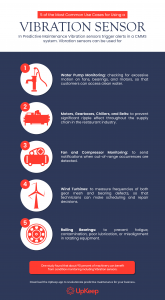What are common use cases for using a vibration sensor in predictive maintenance?
Vibration sensors trigger alerts in a CMMS system when a wide variety of conditions occur including improper calibration of a motor, excessive vibration of a piece of equipment, or too much movement of system fans. Vibration often signals a potential problem within manufacturing and production facilities that can result in future breakdowns or shorter equipment lifespans.

Vibration Sensors Use Cases
These easy-to-use sensors can play a significant role in your preventive maintenance program. Consider these real-life examples of how vibration sensors can be your constant set of eyes in your facility.
Water pump monitoring
Vibration sensors can be placed on condensers or water pumps to monitor for excessive motion on fans, bearings, and motors. Within the water and wastewater industry in particular, pump problems can prevent customers from accessing clean water. Add that to the financial implications of pump downtime, and you have a serious case for using vibration sensors to help.
Motors, gearboxes, chillers, and belts
If you’re running equipment that functions with motors, gearboxes, and conveyor belts, you may benefit from using vibration sensors within the system. For example, when the food and beverage industry experiences problems within these systems, there can be a significant ripple effect throughout the supply chain. Data from vibration sensors can be analyzed over time to support excellent preventive maintenance systems.
Fan and compressor monitoring
Fans play a big role in industrial equipment as well as manufacturing clean rooms. HVAC systems also require working fans and compressors to stay up and running efficiently. Vibration sensors can monitor a myriad of assets, sending notifications when out-of-range occurrences are detected.
Wind turbines
Rotor speed of wind turbines typically fall between 5 rpm and 30 rpm. Vibration sensors work well in this industry because they can easily measure frequencies of both gear mesh and bearing defects. Once this data is returned to a main collection point, technicians can make scheduling and repair decisions.
Rolling bearings
These contact bearings are part of nearly every piece of rotating equipment. This machinery depends upon specific bearings as well as precision functioning of spacers, housing, shafts, and nuts. Although bearing fatigue used to be the measure of failure, recent studies have found that less than 3 percent of failures can be attributed to fatigue. More commonly, bearings are contaminated, lubricated poorly, or misaligned, all of which cause vibration. Sensors, then, can provide the necessarily red flag for preventive maintenance managers.

Want to keep reading?
What are some industry use cases for vibration analysis?
What’s The Difference Between Sensors and Actuators?
The 6 Sensors for Predictive Maintenance That Optimize Repair Timelines
4,000+ COMPANIES RELY ON ASSET OPERATIONS MANAGEMENT
Leading the Way to a Better Future for Maintenance and Reliability
Your asset and equipment data doesn't belong in a silo. UpKeep makes it simple to see where everything stands, all in one place. That means less guesswork and more time to focus on what matters.


![[Review Badge] GetApp CMMS 2022 (Dark)](https://www.datocms-assets.com/38028/1673900459-get-app-logo-dark.png?auto=compress&fm=webp&w=347)
![[Review Badge] Gartner Peer Insights (Dark)](https://www.datocms-assets.com/38028/1673900494-gartner-logo-dark.png?auto=compress&fm=webp&w=336)
